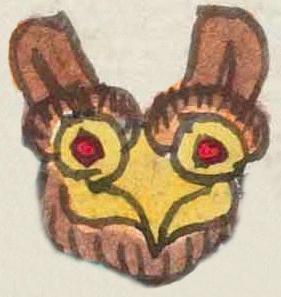tecolotl (Mdz20r)
This element for owl (tecolotl) has been carved from the compound sign for the place name, Tecoloapan. It shows only the head of an owl, in a frontal view. Its red eyes are wide open, and its ears are erect. Its feathers are brown, beak yellow, and the eyes have a yellow ring around the red. For more on the role of the tecolotl in religious belief and the calendar, see Mexicolore.
Stephanie Wood
The owl was laden with symbolism and significance in Nahua culture. A recent article by León García-Garagarza states: "Since ancient times, owls have been considered omens of death in Mexico." The article "analyzes the cultural and linguistic context of this belief among the contact-period Nahuas: the import of tetzahuitl (omens) in the animistic worldview of the Aztecs, as well as the characteristic semantic pair in tecolotl, in chiquatli ('the owl, the barn owl') to signify the lethal activities of the most representative messengers of the Lords of Death and Destiny, Mictlantecuhtli and Tezcatlipoca." [Source: Ethnohistory 7:3 (2020), 455–479.]
Two examples of the tlacatecolotl with heads in a frontal view (while bodies are in a 3/4-view) appears in Diego Durán's Historia de las Indias de Nueva España e Islas de la Tierra Firme, Tomo I (Madrid: Banco Santander, 1990), 197. These are hairy figures with pendant liver/gallbladders (elli) signifying bravery or something more negative. (Personal communication, Gordon Whittaker, 4/19/2023.)
See our Online Nahuatl Dictionary entry for the term, where one will find that Tecolotl could also be a name given to a person. The Matrícula de Huexotzinco includes examples of personal names such as Tlacatecolotl (from folio 876 recto, according to a study by Juan José Batalla, 2018, 80). As Batalla discusses, the iconography of the name glyph there shows a demon or devil, exhibiting considerable Christian influence. The owl here has ears (or feather tufts) that could have a mental association with horns. In certain lights, some owls' eyes can look red (see, for example, the stygian), but the red eyes here could also reflect Christian influences where owls came to be associated with the Devil.
Stephanie Wood
c. 1541, but by 1553 at the latest
Xitlali Torres
owls, tecolotes, buhos

tecolo(tl), owl, lice, demon, devil, https://nahuatl.wired-humanities.org/content/tecolotl
owl
el buho, o piojo blanco de cuerpo
Alonso de Molina
Codex Mendoza, folio 20 recto, https://digital.bodleian.ox.ac.uk/objects/2fea788e-2aa2-4f08-b6d9-648c00..., image 50 of 188.
The Bodleian Libraries, University of Oxford, hold the original manuscript, the MS. Arch. Selden. A. 1. This image is published here under the UK Creative Commons, “Attribution-NonCommercial-ShareAlike 3.0 License” (CC-BY-NC-SA 3.0).




